Discover sustainable home improvement tips for Hawai’i. Learn about the top 10 green remodeling ideas to reduce your carbon footprint and create a more eco-friendly living space in paradise.
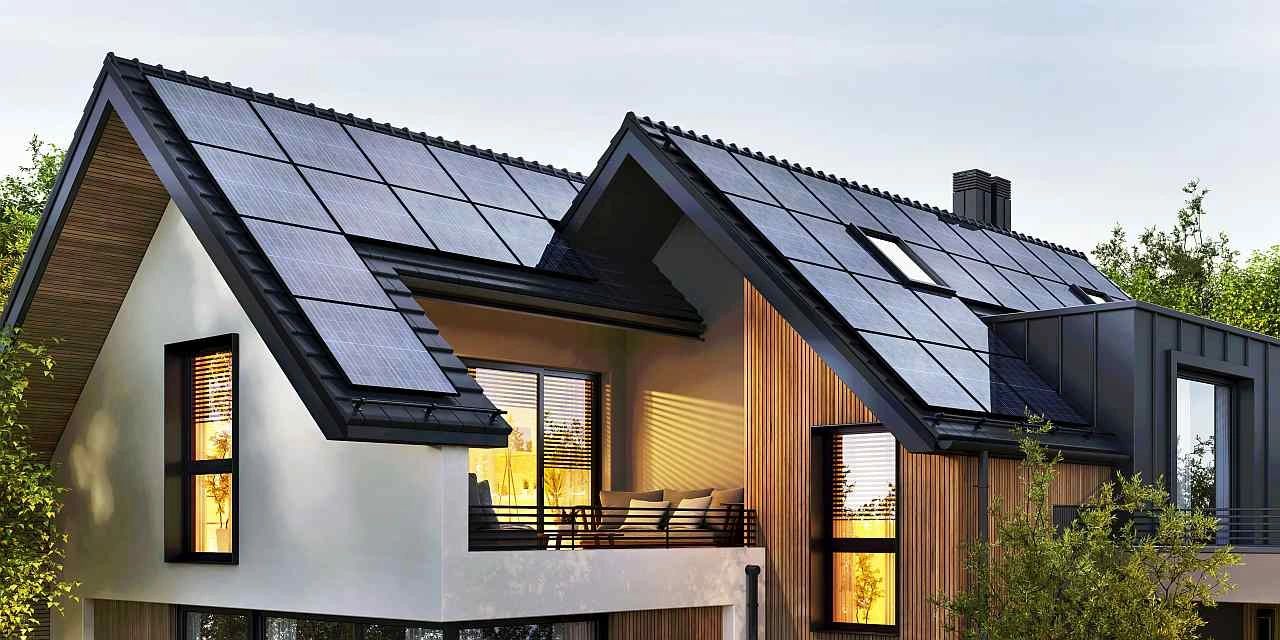
Green Remodeling in Hawai’i: A Sustainable Solution
Hawai’i, a tropical paradise renowned for its natural beauty, faces unique environmental challenges due to its geographic location and climate. As a state heavily reliant on imported fossil fuels, reducing energy consumption and promoting sustainable practices is crucial to protecting the environment and ensuring a more resilient future. Green remodeling offers a practical and effective way to contribute to these goals while enhancing your home’s value and comfort.
This guide will explore the top 10 green remodeling ideas that can significantly reduce your carbon footprint and enhance your home’s energy efficiency. By incorporating these sustainable practices into your home improvement projects, you can play a vital role in preserving Hawai’i’s natural resources and creating a healthier, more sustainable living environment.
Mahalo for joining us for this week’s Home Renovation Blog at Eco-Luxe Living: Hawai’i!
1. Harnessing the Sun’s Power: Solar Panel Installation
Hawai’i, with its abundant sunlight and favorable climate, is an ideal location for solar panel installation. Solar energy offers a clean, renewable alternative to traditional fossil fuels, providing numerous benefits for both homeowners and the environment.

Advantages of Solar Panels in Hawai’i:
- Abundant Sunlight: Hawai’i’s tropical climate provides ample sunlight throughout the year, making it an excellent location for solar energy generation.
- Tax Incentives: The state offers various tax incentives and rebates to encourage solar panel adoption, making it more affordable for homeowners.
- Reduced Energy Costs: By generating your own electricity, you can significantly reduce your reliance on the grid and lower your monthly energy bills.
- Environmental Benefits: Solar panels produce clean energy without harmful emissions, helping to reduce air pollution and combat climate change.
Types of Solar Panels:
- Crystalline Silicon: The most common type of solar panel, known for its efficiency and durability.
- Thin-Film: A newer technology that is typically more flexible and can be installed on various surfaces.
- Concentrating Solar Power (CSP): A system that uses mirrors to concentrate sunlight and generate heat, which is then converted into electricity.
Installation Options:
- Rooftop Installation: The most common option, where solar panels are mounted on your roof.
- Ground-Mounted Systems: Suitable for larger homes or properties with limited roof space, where panels are installed on the ground.
- Hybrid Systems: A combination of rooftop and ground-mounted systems for maximum energy production.
2. Window to a Brighter Future: Energy-Efficient Windows
Energy-efficient windows are more than just a stylish addition to your home; they are a practical investment that can significantly reduce your energy consumption and improve your overall comfort. By replacing outdated windows with energy-efficient options, you can enhance your home’s insulation, lower your energy bills, and contribute to a more sustainable future.
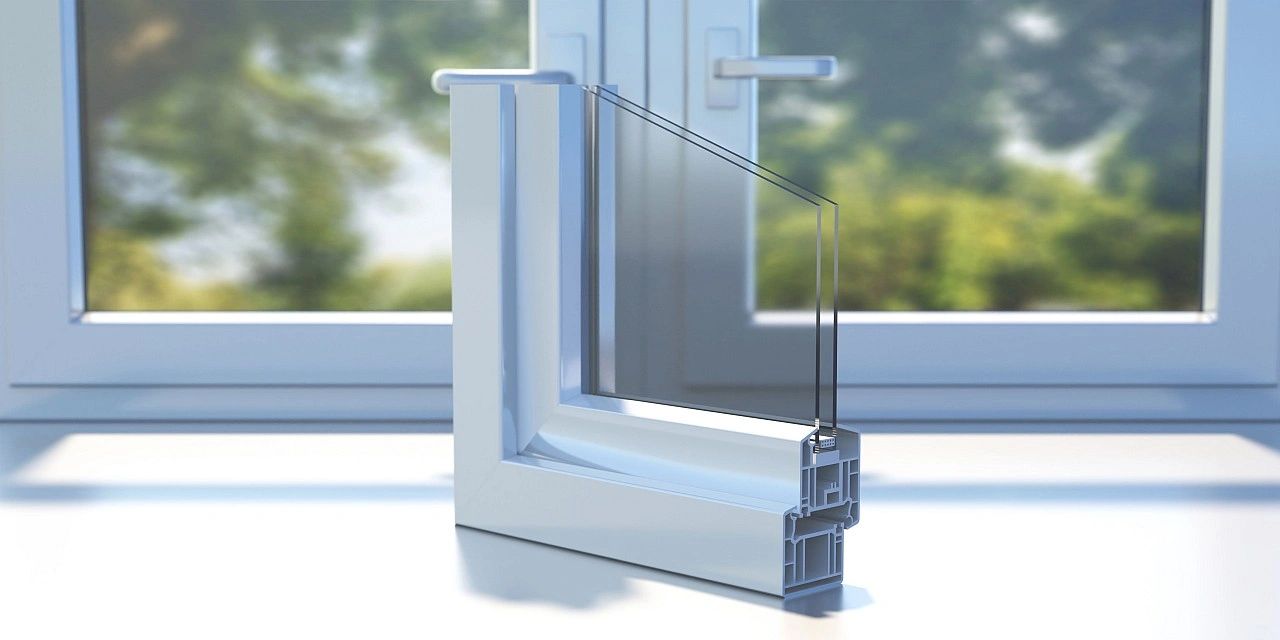
Benefits of Energy-Efficient Windows:
- Improved Insulation: Energy-efficient windows are designed to minimize heat transfer, keeping your home cooler in the summer and warmer in the winter. This improved insulation helps to reduce energy consumption and create a more comfortable living environment.
- Reduced Energy Consumption: By preventing heat loss and gain, energy-efficient windows can significantly lower your heating and cooling costs. This can lead to substantial savings on your energy bills over time.
- Enhanced Comfort: Well-insulated windows can help to reduce drafts and temperature fluctuations, creating a more comfortable and enjoyable living space.
Factors to Consider When Choosing Energy-Efficient Windows:
- Materials: The materials used in the construction of your windows can greatly impact their energy efficiency. Look for windows made with high-quality materials, such as low-E glass and durable frames.
- Glazing: The number of panes and the type of glazing used in your windows can also affect their energy efficiency. Double-pane windows with low-E coatings are generally more energy-efficient than single-pane windows.
- Frames: The material and construction of your window frames can also influence their energy efficiency. Look for frames made from materials that provide good insulation, such as vinyl or fiberglass.
Pro Tip: Budget-friendly, energy-efficient windows are in stock at most big box stores in Hawai’i.
3. Lighting Up Your Home with LEDs: A Bright Idea
LED lighting has revolutionized the way we illuminate our homes, offering numerous benefits over traditional incandescent and fluorescent bulbs. By switching to LED lighting, you can reduce energy consumption, lower your electricity bills, and create a more sustainable living environment.
Benefits of LED Lighting:
- Long Lifespan: LED bulbs are known for their exceptional durability, lasting significantly longer than traditional bulbs. This means fewer replacements and reduced maintenance costs.
- Energy Efficiency: LEDs consume far less energy than traditional bulbs, resulting in substantial savings on your electricity bills.
- Reduced Heat Generation: Unlike traditional bulbs, LEDs produce minimal heat, reducing the risk of fire hazards and improving energy efficiency.
Choosing the Right LED Bulbs and Fixtures:
- Color Temperature: LED bulbs come in various color temperatures, ranging from warm white to cool white. Consider the desired ambiance for different areas of your home. (My favorite color temperature is 2700k, a nice warm white!)
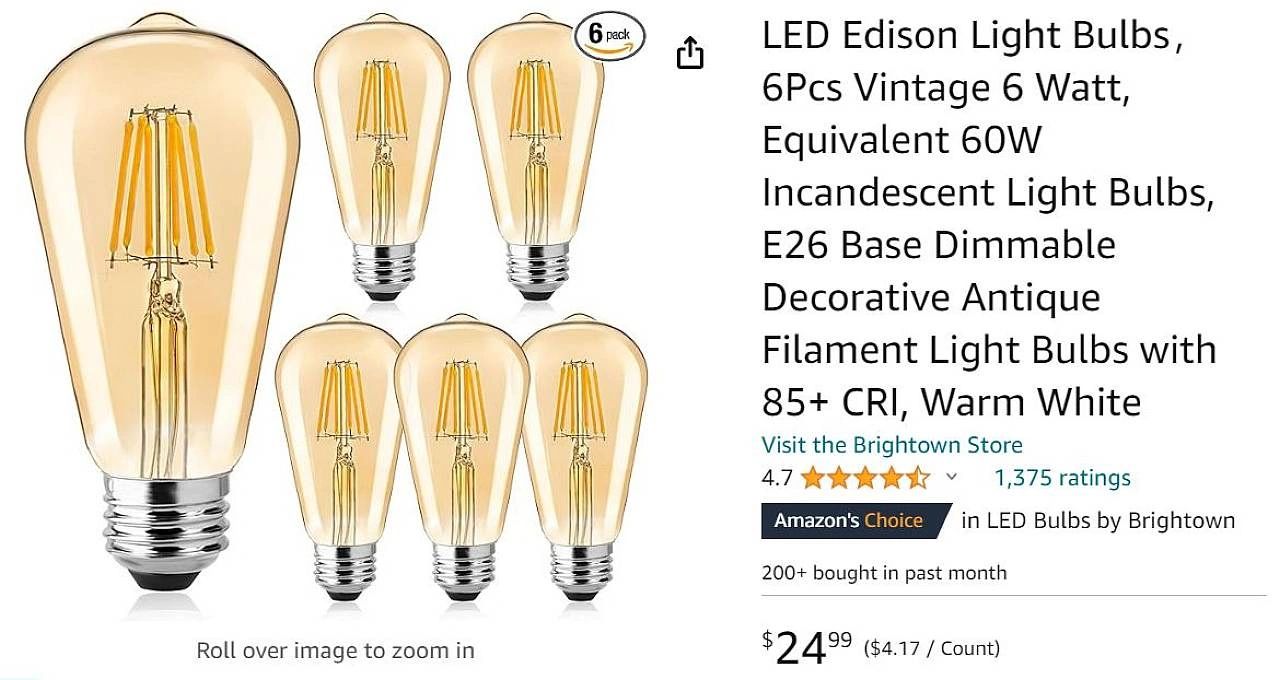
- Lumens: Lumens measure the brightness of a light bulb. Choose the appropriate lumen output based on the size and purpose of the room or space.
- Dimmability: Ensure that the LED bulbs and fixtures you choose are compatible with your existing dimming system if you prefer to adjust the brightness.
- Application: Different areas of your home may require specific types of LED bulbs or fixtures. For example, recessed lighting may require different bulbs than pendant lights.
4. A Drop in the Bucket: Water-Saving Fixtures
Water conservation is a critical issue in Hawai’i, where limited freshwater resources and increasing population pressure make it essential to reduce water consumption. By upgrading your plumbing fixtures to water-saving models, you can significantly reduce your water bill, protect the environment, and contribute to a more sustainable future.
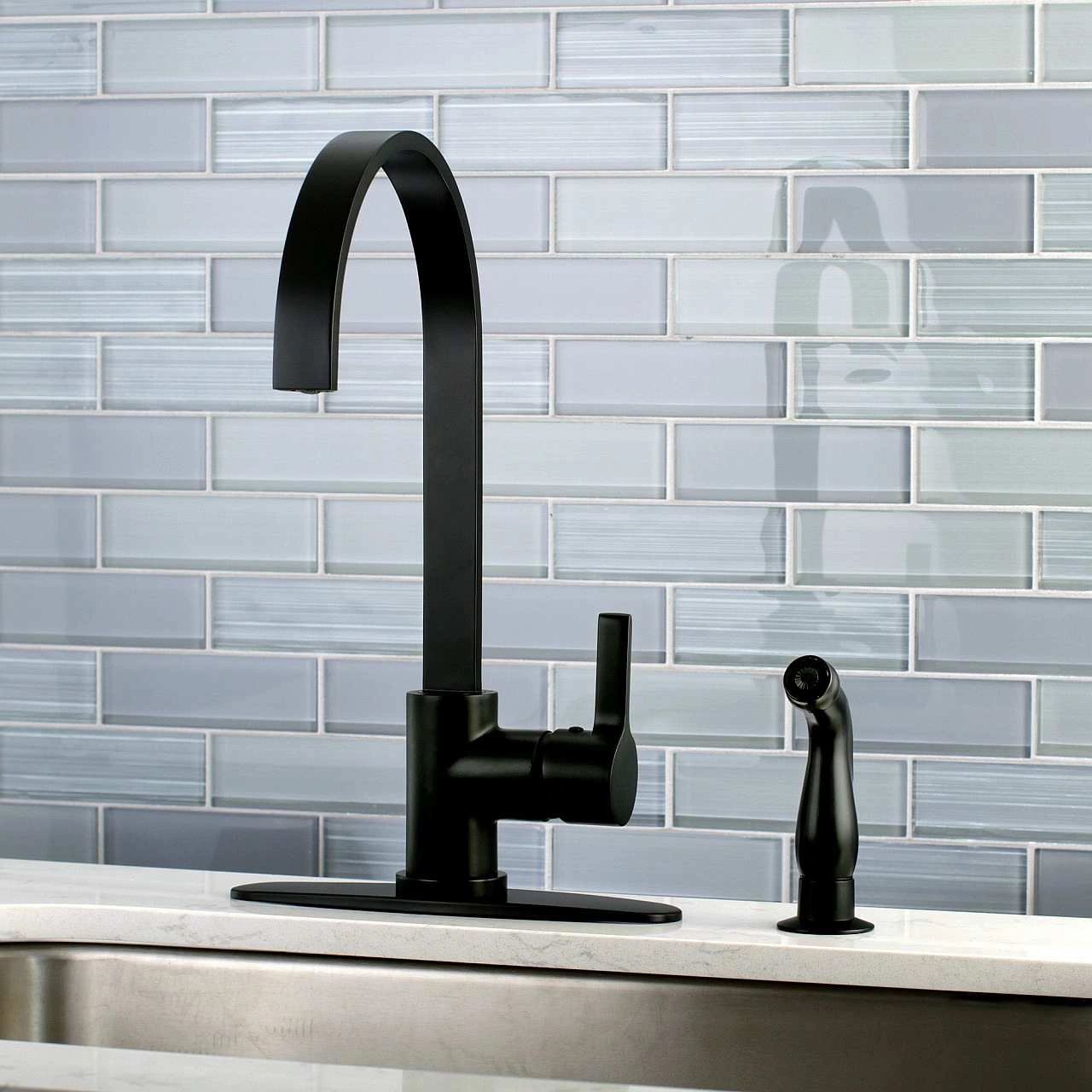
The Importance of Water Conservation:
- Limited Freshwater Resources: Hawai’i’s freshwater resources are finite, and increasing population and tourism demand can strain supplies.
- Environmental Impact: Excessive water use can contribute to pollution, habitat destruction, and other environmental problems.
- Reduced Water Bills: By conserving water, you can lower your monthly water bill and save money.
Water-Saving Fixtures:
- Toilets: Low-flow toilets use significantly less water per flush than traditional models. Look for toilets with a rating of 1.28 gallons per flush (GPF) or less.
- Faucets: Aerated faucets reduce water flow without sacrificing pressure. Choose faucets with a flow rate of 1.5 gallons per minute (GPM) or less.
- Showerheads: Low-flow showerheads can reduce water consumption without sacrificing water pressure. Look for showerheads with a flow rate of 2.5 gallons per minute (GPM) or less.
- Irrigation Systems: Efficient irrigation systems can help to reduce water waste in your yard. Consider using drip irrigation or soaker hoses to deliver water directly to the roots of your plants.
5. Greening Your Roof: Sustainable Design
A green roof, also known as a living roof, is a sustainable design feature that involves planting vegetation on a rooftop. Green roofs offer numerous benefits for both your home and the environment, making them a popular choice for homeowners seeking to reduce their carbon footprint and create a more sustainable living space.

Benefits of Green Roofs:
- Improved Insulation: Green roofs provide excellent insulation, helping to keep your home cooler in the summer and warmer in the winter. This can significantly reduce your energy consumption and lower your energy bills.
- Stormwater Management: Green roofs can help to mitigate the impacts of stormwater runoff by absorbing rainwater and reducing the burden on municipal drainage systems. This can help to prevent flooding and erosion.
- Improved Air Quality: Green roofs can help to improve air quality by filtering pollutants from the air and releasing oxygen.
- Biodiversity: Green roofs can provide habitat for various plants and animals, contributing to biodiversity and enhancing the local ecosystem.
Types of Green Roofs:
- Extensive Green Roofs: These roofs are characterized by a shallow soil layer and low-maintenance vegetation, such as sedums and grasses. They are well-suited for larger roof areas and require minimal maintenance.
- Intensive Green Roofs: These roofs have a deeper soil layer and can support a wider variety of plants, including trees and shrubs. They are more complex to install and require regular maintenance.
Factors to Consider When Planning a Green Roof Installation:
- Roof Structure: Your roof must be able to support the weight of a green roof, including the soil, plants, and irrigation system.
- Climate: Consider the local climate and the types of plants that can thrive in your region.
- Maintenance: Green roofs require regular maintenance, including watering, weeding, and pruning.
- Budget: The cost of a green roof installation can vary depending on the size, type, and complexity of the project.
6. Insulate and Save: Energy-Efficient Homes
While Hawai’i is known for its warm climate, proper insulation is still essential for maintaining a comfortable and energy-efficient home. Insulation helps to prevent heat loss in the winter and heat gain in the summer, reducing your reliance on heating and cooling systems and lowering your energy bills.
The Importance of Insulation in Hawai’i:
- Reduced Energy Consumption: Insulation helps to keep your home at a comfortable temperature without excessive energy use. This can significantly reduce your heating and cooling costs.
- Improved Comfort: Proper insulation can help to eliminate drafts and temperature fluctuations, creating a more comfortable living environment.
- Reduced Moisture Issues: Insulation can help to prevent moisture buildup, which can lead to mold and mildew growth.
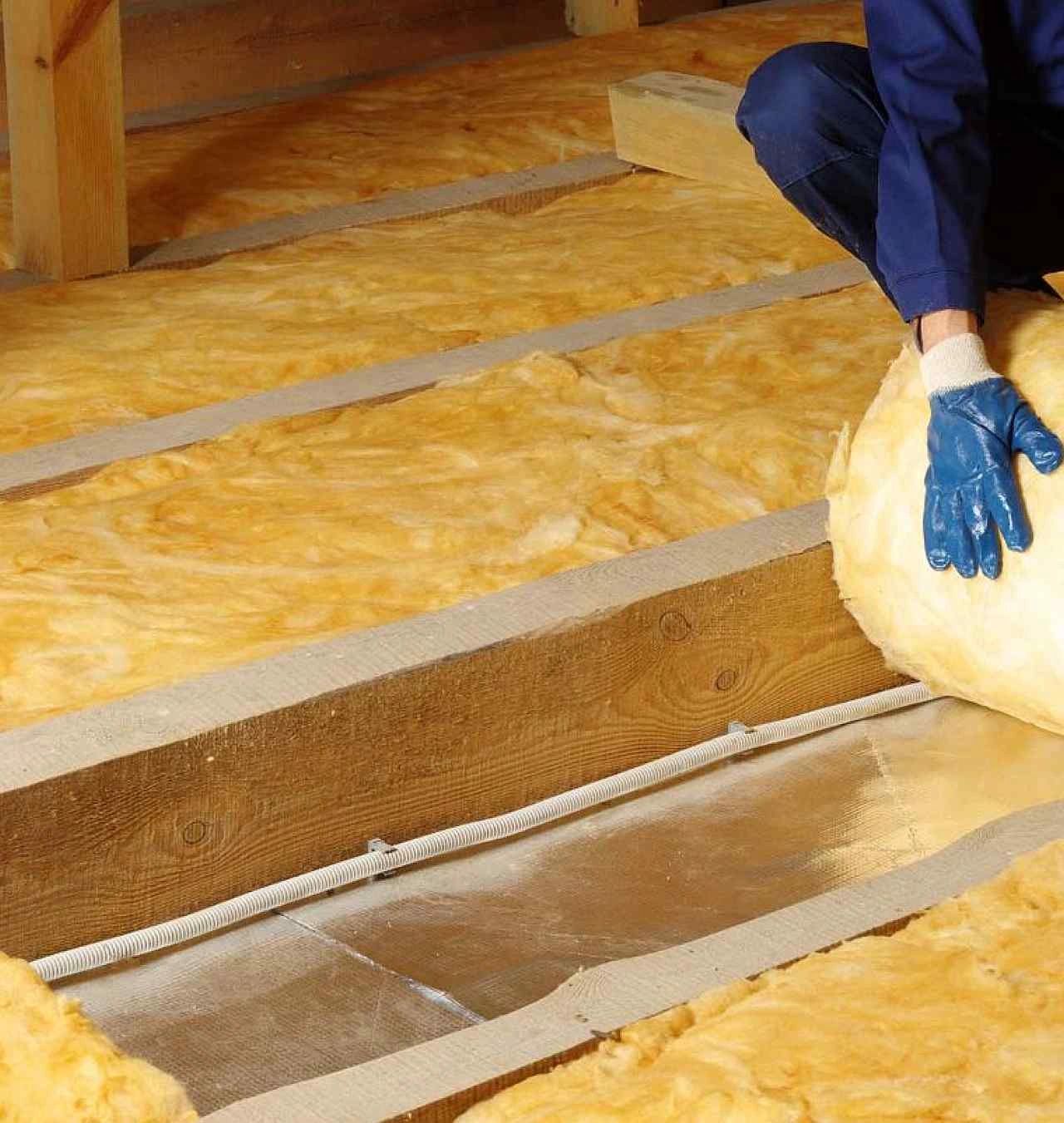
Types of Insulation:
- Fiberglass: A common insulation material that is available in batts, rolls, and loose-fill forms.
- Cellulose: Made from recycled paper, cellulose insulation is a good choice for both new and existing homes.
- Rock Wool: A fire-resistant insulation material that is often used in commercial buildings and high-temperature applications.
- Spray Foam: A high-density insulation that can be sprayed into cavities to create a continuous air seal.
Best Practices for Insulation Installation:
- Professional Installation: For optimal results, it’s recommended to hire a qualified professional to install insulation.
- Air Sealing: Ensure that all air leaks are sealed before installing insulation to prevent drafts and energy loss.
- R-Value: The R-value of insulation indicates its resistance to heat flow. Choose insulation with an appropriate R-value for your climate and home.
- Ventilation: Proper ventilation is essential to maintain indoor air quality and prevent moisture problems.
7. Building with Nature: Natural and Recycled Materials
Incorporating natural and recycled materials into your home remodeling project can have a significant positive impact on both the environment and your indoor air quality. By choosing sustainable materials, you can reduce your carbon footprint, support local economies, and create a healthier living space.
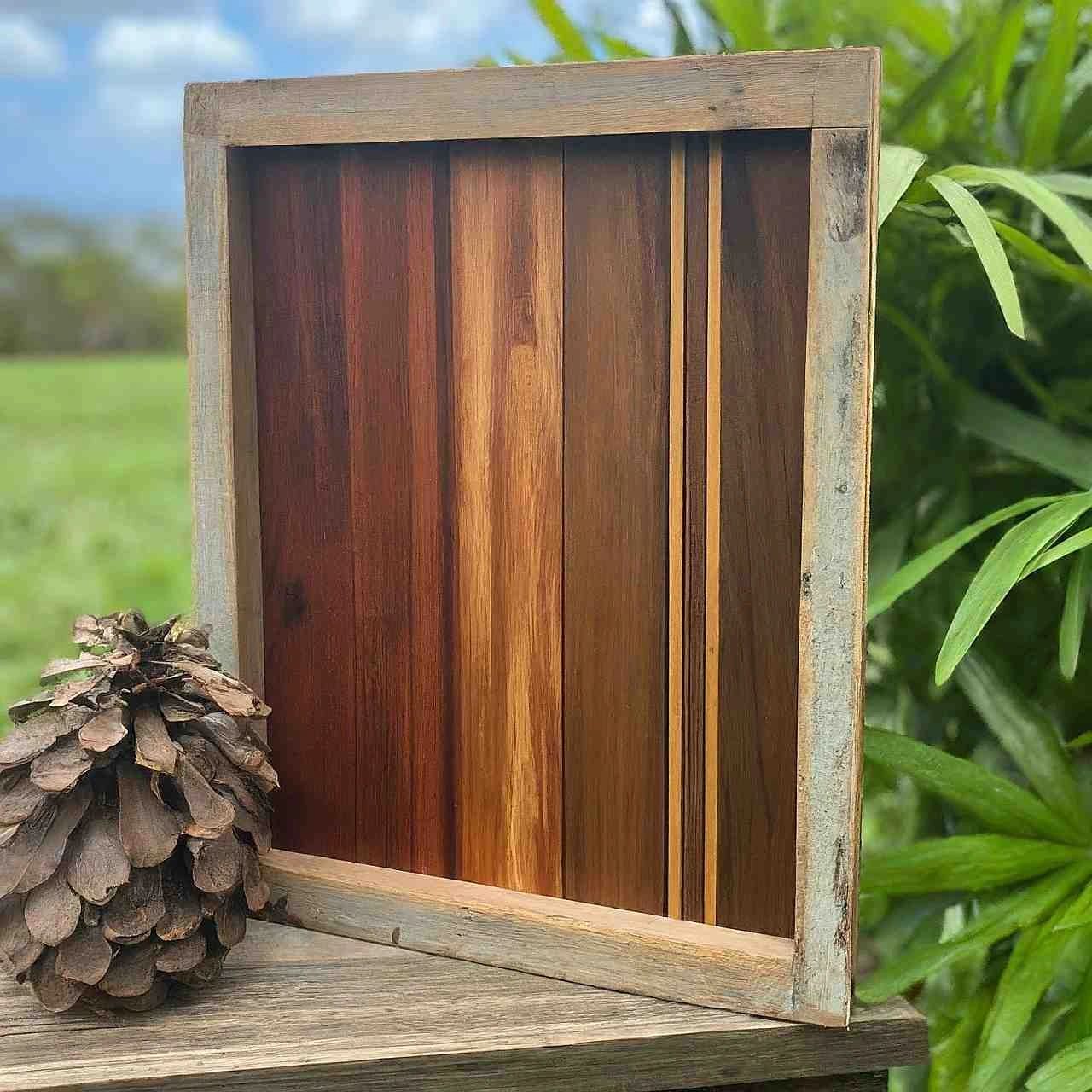
Benefits of Natural and Recycled Materials:
- Reduced Environmental Impact: Using natural and recycled materials can help to conserve resources, reduce waste, and minimize pollution.
- Improved Indoor Air Quality: Many synthetic building materials can release harmful chemicals into the air, contributing to indoor air pollution. Natural and recycled materials are often less toxic and can help to create a healthier living environment.
- Enhanced Aesthetics: Natural materials, such as wood and stone, can add warmth, character, and a sense of natural beauty to your home.
Examples of Sustainable Materials:
- Bamboo: Bamboo is a fast-growing and highly renewable resource that is sturdy, beautiful, and versatile. It’s ideal for flooring, furniture, and even structural components of your home.
- Reclaimed Wood: Reclaimed wood is a popular choice for flooring, cabinetry, and architectural details. It adds character to your home while preventing the depletion of new timber resources. Our favorite place to find reclaimed wood is Re-use Hawai’i, a nonprofit dedicated to “cultivating a circular economy through material waste reduction and redistribution.” Their inventory is sourced through their “Deconstruction Program,” community donations, and surplus stock. It’s a great way to save money, decrease waste, and reduce Hawaii’s import reliance. Using reclaimed wood for accent walls and wood feature walls is one of our favorite eco-friendly home renovation projects!
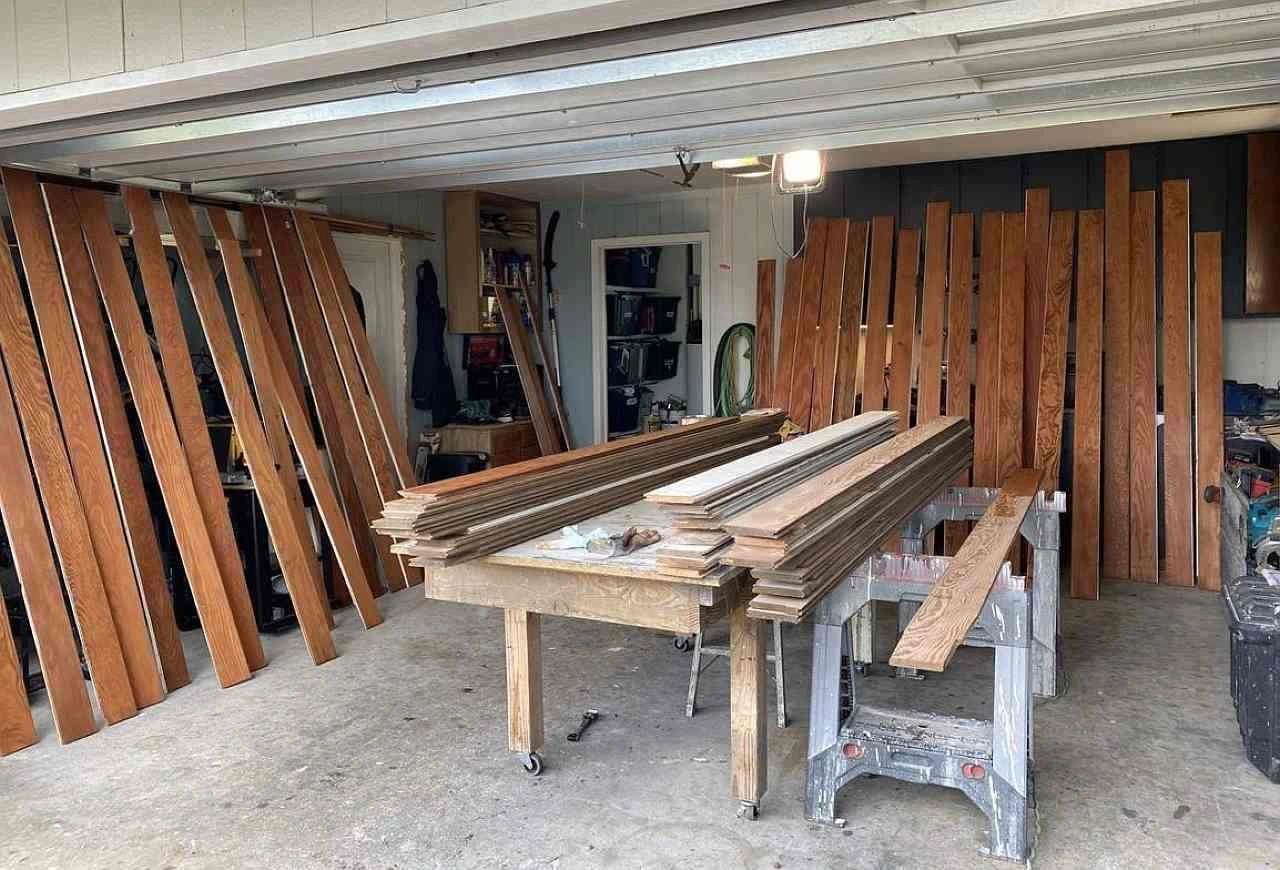
- Stone: Natural stone, such as granite, marble, and limestone, is a durable and sustainable building material.
- Cork: Cork is a renewable and biodegradable material that can be used for flooring, wall coverings, and insulation.
- Recycled Materials: Look for recycled materials, such as recycled glass, aluminum, and steel, for various home remodeling projects. Utilize recycled glass in countertops and decorative elements. This not only reduces waste but also adds a touch of elegance to your home. Reclaimed tiles can be used for flooring, backsplashes, and even artistic mosaic designs. They bring a sense of history and charm to your home renovation project.
- Sustainable Paints and Finishes: Use low volatile organic compound (VOC) paints to minimize indoor air pollution. This is especially important in Hawaii’s humid climate, where indoor air quality can significantly impact health.
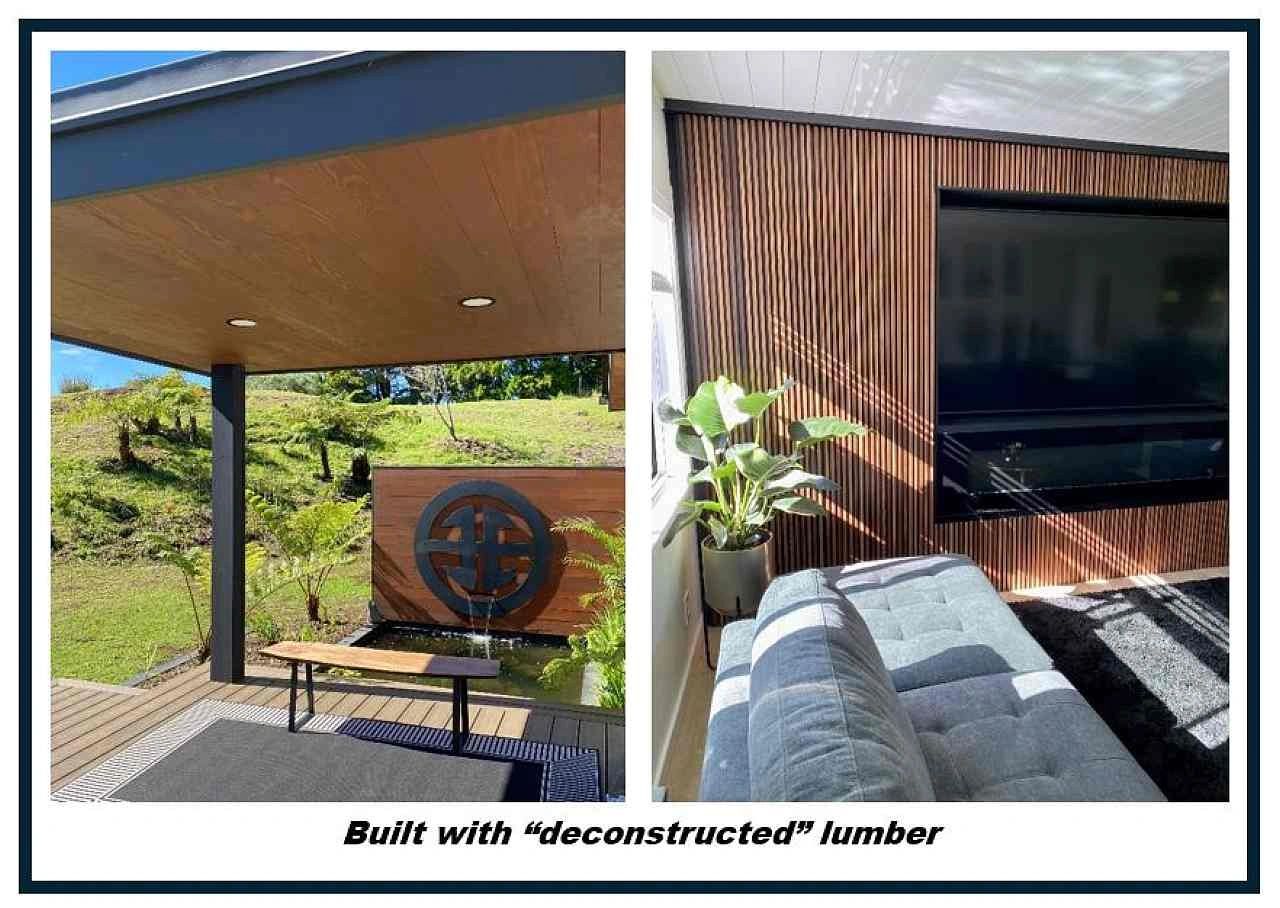
Pro Tip: For more great tips on green remodeling ideas and where to find budget-friendly, sustainable products in Hawai’i, check out all of our Home Renovation Blog posts.
8. Capturing Nature’s Bounty: Rainwater Harvesting Systems
Hawai’i, with its abundant rainfall, offers an excellent opportunity to harness this natural resource for your home’s water needs. Rainwater harvesting systems can provide a sustainable and cost-effective way to supplement your municipal water supply, reduce your water bill, and contribute to environmental conservation.
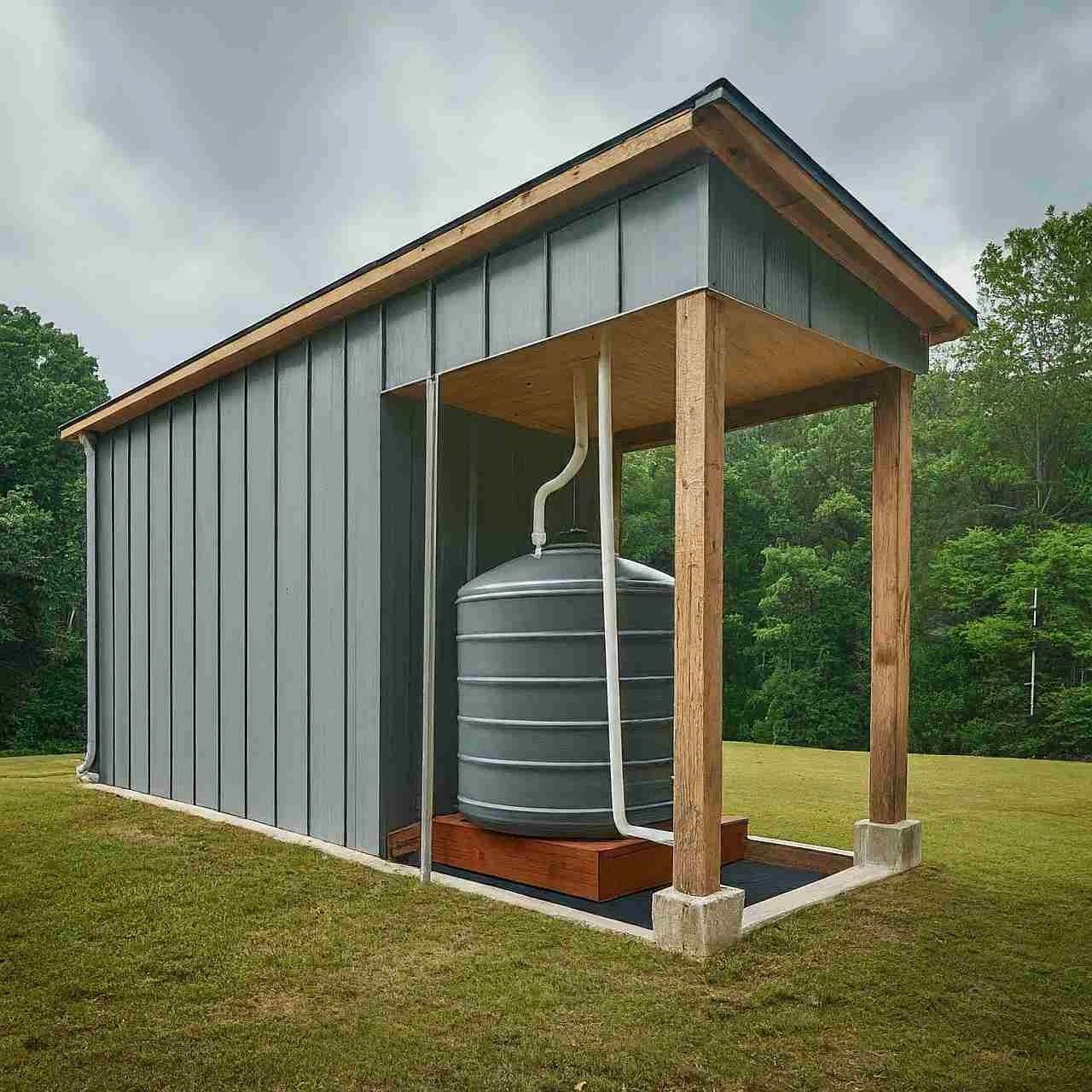
Benefits of Rainwater Harvesting:
- Reduced Reliance on Municipal Water Supply: By collecting and storing rainwater, you can reduce your dependence on municipal water sources, helping to conserve this precious resource.
- Potential Cost Savings: Rainwater harvesting can significantly reduce your water bill, especially during dry periods or if you have a large property.
- Environmental Benefits: Rainwater harvesting helps to reduce stormwater runoff, which can help to prevent pollution and erosion.
- Off-Grid Capability: In the event of a water supply disruption, a rainwater harvesting system can provide a reliable source of water.
Types of Rainwater Harvesting Systems:
- Cistern or Tank: A large container that collects and stores rainwater. Cisterns can be made of a variety of materials, including concrete, plastic, or metal.
- Barrel: A smaller container that is often used for collecting rainwater from rooftops. Barrels can be made of plastic or metal.
- Underground Tanks: These tanks are buried beneath the ground to help maintain water quality and temperature.
Factors to Consider When Planning an Installation:
- Roof Area: The size of your roof will determine the amount of rainwater you can collect.
- Water Quality: Consider the quality of your roof and any potential contaminants that may be present in the rainwater.
- Storage Capacity: Determine the amount of water you need to store for your household needs.
- Plumbing and Filtration: Plan for the necessary plumbing and filtration systems to distribute and purify the collected rainwater.
- Local Regulations: Check your local regulations regarding rainwater harvesting to ensure compliance.
9. Smarter Homes, Greener Future: Smart Home Technology
Smart home technology offers a convenient and efficient way to automate various aspects of your home, including energy management. By integrating smart devices into your home remodeling project, you can optimize energy consumption, reduce your carbon footprint, and create a more sustainable living space.
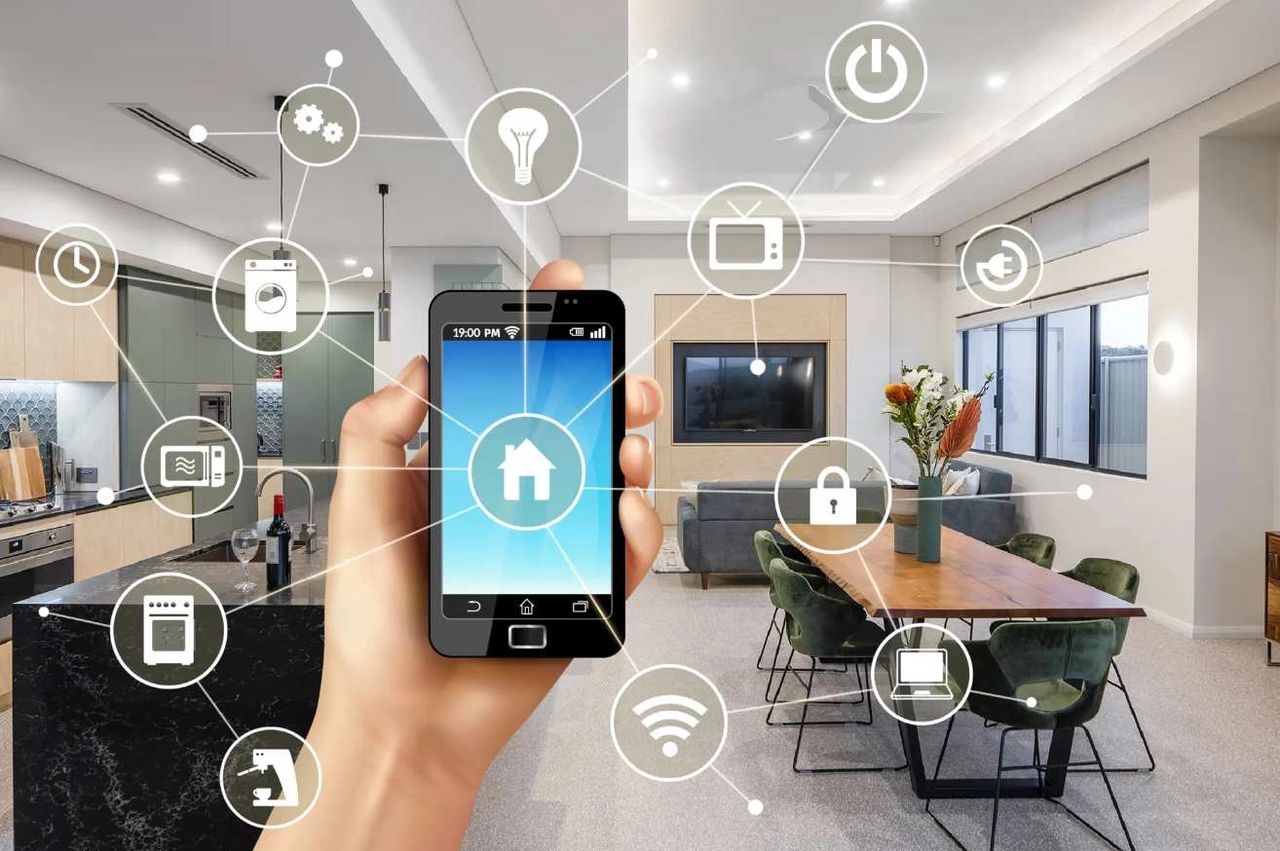
How Smart Home Technology Can Contribute to Green Remodeling:
- Automated Energy-Saving Features: Smart thermostats, lighting controls, and appliances can be programmed to adjust based on your preferences and usage patterns, helping to reduce energy waste.
- Optimized Energy Consumption: Smart home systems can monitor your energy usage and identify areas for improvement. This data can help you make informed decisions about your energy consumption and implement energy-saving measures.
Examples of Smart Home Devices for Green Remodeling:
- Smart Thermostat: A smart thermostat can automatically adjust your home’s temperature based on your schedule and preferences, helping to save energy.
- Smart Lighting Controls: Smart lighting systems allow you to control your lights from anywhere, enabling you to turn off lights in unoccupied rooms and adjust the brightness to suit your needs.
- Smart Appliances: Energy-efficient appliances equipped with smart features can optimize their energy consumption and provide valuable data on your usage patterns.
- Energy Management Systems: A comprehensive energy management system can monitor your home’s energy consumption, identify areas for improvement, and automate energy-saving features.
10. Paving the Way for a Greener Future: Permeable Paving
Permeable paving is a sustainable alternative to traditional impervious paving materials like asphalt and concrete. By allowing rainwater to infiltrate into the ground, permeable paving can help to reduce stormwater runoff, prevent flooding, and improve water quality.
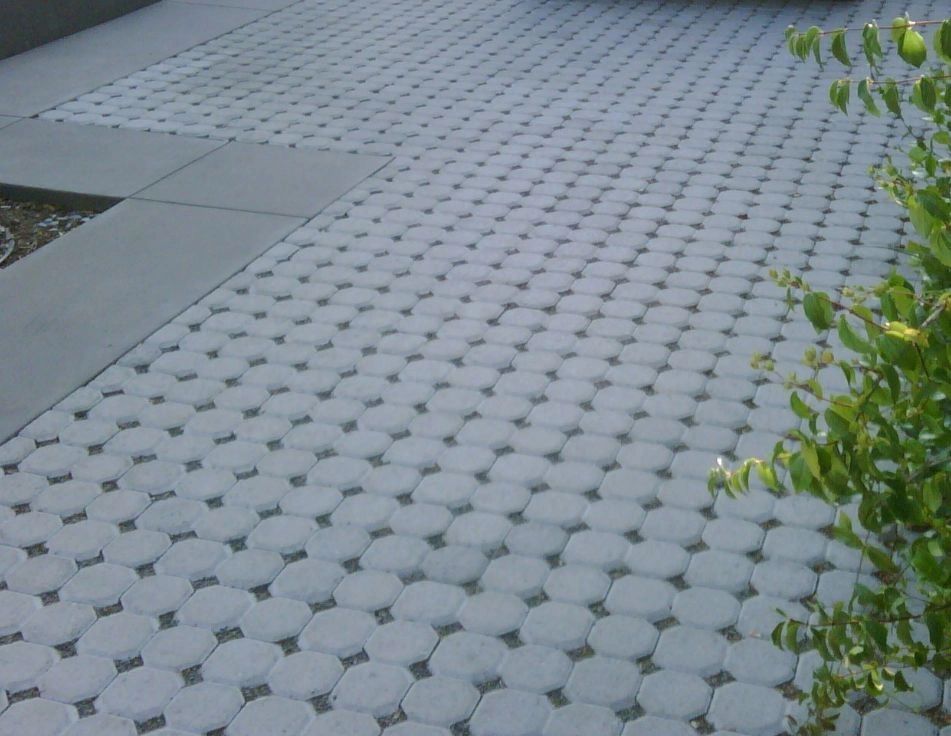
Benefits of Permeable Paving:
- Stormwater Management: Permeable paving can help to reduce stormwater runoff, which can contribute to flooding, erosion, and pollution.
- Improved Water Quality: By allowing rainwater to infiltrate into the ground, permeable paving can help to filter pollutants and improve water quality.
- Reduced Heat Island Effect: Permeable paving can help to reduce the urban heat island effect by allowing rainwater to evaporate and cool the surrounding area.
Types of Permeable Paving Materials:
- Porous Concrete: A type of concrete that contains voids that allow water to infiltrate.
- Permeable Interlocking Concrete Pavers: These pavers are designed with gaps between them to allow water to pass through.
- Gravel: Gravel can be used as a permeable paving material, providing a natural and low-maintenance option.
- Recycled Materials: Recycled materials, such as recycled plastic or rubber, can be used to create permeable paving surfaces.
Applications in Home Remodeling:
- Driveways: Permeable paving can be used for driveways, providing a sustainable and environmentally friendly alternative to traditional asphalt or concrete.
- Patios and Walkways: Permeable paving can also be used for patios and walkways, adding a touch of natural beauty to your outdoor living space.
- Extend your eco-friendly efforts to your outdoor spaces by planting native and drought-resistant plants along your driveway and using organic gardening practices.
Conclusion: A Greener Home, A Brighter Future
Incorporating green remodeling ideas into your home improvement projects can have a significant positive impact on both your environment and your lifestyle. By choosing sustainable materials, investing in energy-efficient technologies, and adopting water-saving practices, you can reduce your carbon footprint, lower your energy bills, and create a healthier, more comfortable living space.
Recap of Top 10 Green Remodeling Ideas for Hawai’i:
- Solar Panel Installation
- Energy-Efficient Windows
- LED Lighting Conversion
- Water Saving Fixtures
- Green Roof Installation
- Insulation Upgrade
- Natural and Recycled Materials
- Rainwater Harvesting System
- Smart Home Technology
- Permeable Paving
Don’t wait to start your green remodeling journey! By making small changes to your home, you can contribute to a more sustainable future and enjoy the many benefits of green living. Start by assessing your home’s energy efficiency and identifying areas for improvement. Consider consulting with a green building professional to get personalized advice and recommendations.
As always, mahalo for joining us for this week’s Home Renovation Blog! Let us know if you have questions or comments, we’d love to hear from you! Be sure to check out our weekly home blog and subscribe for all the latest tips and tricks for creating your modern, organic oasis.


Additional Resources for Green Remodeling in Hawai’i
General Green Remodeling Information
- Hawai’i Green Building Alliance
- U.S. Department of Energy
- U.S. Green Building Council
- Environmental Protection Agency (EPA)
Sustainable Materials and Products
- GreenGuard Product Certifications
- Recycled Products Association
- Energy Star Appliances
- ReUse Hawai’i (sustainable construction materials)
Indoor Air Quality
Green Remodeling Tips and Resources
- Green Building Advisor
- Remodeling Magazine
- HomeAdvisor
- Local Building Contractors: Research local contractors who specialize in green building and sustainable home improvement.
